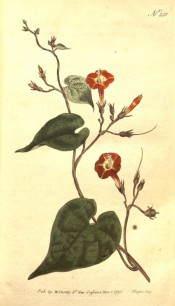Ipomoea coccinea L.
Frost tender annual twining climber with entire or toothed leaves, to 14cm long, and racemes of 3-8 scarlet flowers, to 2cm across, with yellow throats, in summer. To 4m. [RHSE, Hortus].
Horticultural & Botanical History
‘The present species is a twining plant, will run up a stick to the height of six, eight, or ten feet, and produce an abundance of flowers, of a rich orange colour, tending to scarlet, which renders it one of the most ornamental annuals cultivated in our gardens, into which it not as yet greatly introduced, though cultivated by Mr. Miller in 1759.’ [BM t.221/1793]. Ipomea coccinea was also figured in Andrews’ Botanical Repository, with the suggestion that the plant figured in Curtis’s Botanical Magazine is not the true I. coccinea. [ABR pl.499/1808].
History at Camden Park
Listed in the 1857 catalogue only [T.576/1857]. Seed was ordered from Hurst and McMullen, Seedsmen and Florists of London, on 8th April 1846, the probable source [MP A2933-1, p.132]. I recently found a plant growing in a weed-infested part of the garden, the first time it had been seen in living memory.
Notes
Ipomoea coccinea Rottl. (1803) = Ipomoea hederifolia L.
Published Mar 09, 2009 - 03:42 PM | Last updated Jul 16, 2010 - 03:30 PM
| Family | Convolvulaceae |
|---|---|
| Category | |
| Region of origin | Southern USA |
| Synonyms |
|
| Common Name | Red morning glory, Star morning glory |
| Name in the Camden Park Record | Ipomoea coccinea |
| Confidence level | high |
